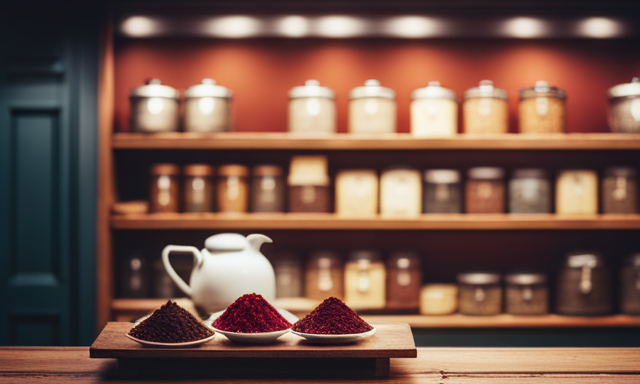Did you know that cold brewing rooibos tea can extract more antioxidants and flavor compared to traditional hot brewing methods? It’s true! As an avid tea enthusiast, I’ve discovered the incredible benefits and taste that cold brewing brings to this South African herbal tea.
In this article, I will guide you through the step-by-step process of cold brewing rooibos, ensuring that you achieve the perfect brew every time.
First, we’ll delve into the benefits of cold brewing rooibos, highlighting why it’s the preferred method for many tea lovers.
Then, we’ll explore how to choose the right rooibos tea leaves and prepare the ideal pitcher for cold brewing.
I’ll also share tips on measuring the right amount of tea leaves and adding delightful flavors with fruits and herbs.
Additionally, you’ll learn how to strain and store your cold-brewed rooibos, and I’ll provide serving suggestions and creative recipes to elevate your tea experience.
So, grab your favorite rooibos tea and let’s embark on this refreshing and healthy journey of cold brewing!
Key Takeaways
- Cold-brewing rooibos creates a refreshing glass of chilled rooibos.
- Brewing time affects the flavor of cold-brewed rooibos.
- Longer steeping extracts more flavor and antioxidants.
- Experiment with brewing times to find the perfect cup.
Understanding the Benefits of Cold Brewing Rooibos
Cold brewing rooibos brings out the full flavor and natural sweetness, resulting in a refreshing and vibrant iced tea. Understanding the taste profile of rooibos is key to achieving the perfect cold brew.
Rooibos is naturally caffeine-free and has a smooth, earthy taste with hints of vanilla and honey. When cold brewed, these flavors become more pronounced, creating a well-balanced and aromatic drink.
Experimenting with different brewing times allows you to customize the strength of the tea to your liking. Generally, steeping rooibos in cold water for 8-12 hours yields a mellow and subtly sweet brew. For a stronger flavor, you can extend the brewing time up to 24 hours.
Now that you understand the benefits of cold brewing rooibos, let’s move on to choosing the right rooibos tea for your cold brew.
Choosing the Right Rooibos Tea
To find the perfect rooibos tea for your cold brewing adventure, you’ll want to explore different varieties like a curious explorer searching for hidden treasures.
When choosing the right rooibos tea, consider the purchasing options available to you. Look for reputable brands that offer high-quality loose leaf or tea bags.
Next, consider the flavor profiles you desire. Rooibos tea comes in a range of flavors, from earthy and woody to fruity and floral. Experiment with different options to find your favorite.
Additionally, consider the brewing methods that suit your taste. Some people prefer a stronger brew, while others enjoy a milder infusion.
Lastly, remember the health benefits of rooibos tea, such as its rich antioxidants and potential immune-boosting properties. With all these factors in mind, you can choose the perfect rooibos tea for your cold brewing experience.
Now, let’s move on to preparing the perfect pitcher for cold brewing.
Preparing the Perfect Pitcher for Cold Brewing
Start by selecting a pitcher that not only suits your style but also allows for the perfect infusion of flavors. Look for a pitcher that’s made of glass or BPA-free plastic, as these materials won’t interfere with the taste of the tea. Additionally, choose a pitcher with a tight-fitting lid to prevent any unwanted flavors from seeping in.
Once you have your pitcher, it’s time to gather your measuring equipment. You’ll need a tablespoon or a tea scoop to measure the right amount of tea leaves. For a standard pitcher, use around 4 tablespoons of rooibos tea. Adjust the amount depending on the size of your pitcher and your personal preference.
Next, add cold water to the pitcher, ensuring that the tea leaves are fully submerged. Let the tea steep in the refrigerator for at least 8 hours or overnight for the best results. This extended infusion time allows the flavors to fully develop and results in a smooth and refreshing cup of cold brewed rooibos.
Moving on to the next section about measuring the right amount of tea leaves, it’s important to get the perfect balance to achieve the desired taste.
Measuring the Right Amount of Tea Leaves
Achieve the perfect balance of flavors by carefully measuring the right amount of tea leaves. This will allow you to create a truly exceptional cup of refreshing goodness.
When it comes to measuring techniques for cold brewing rooibos, precision is key. Start by using a ratio of 1 tablespoon of loose rooibos tea leaves for every 8 ounces of water. This will ensure that the flavors are strong enough without becoming overpowering.
Adjust the amount of tea leaves based on your personal preference for a stronger or milder brew. Once you’ve measured the tea leaves, it’s time to let them steep in cold water for at least 8 hours or overnight. This extended brewing time allows the flavors to fully infuse into the water, resulting in a smooth and flavorful cup of cold brewed rooibos tea.
Now, let’s move on to adding flavor with fruits and herbs, enhancing the already delightful taste of your cold brew.
Adding Flavor with Fruits and Herbs
Enhance your cold brewed tea experience by infusing it with the vibrant flavors of fresh fruits and aromatic herbs. Here are five ways to enjoy a fruit infused rooibos and explore herbal twists:
- Add slices of ripe strawberries for a burst of sweetness.
- Try a handful of blueberries for a subtle tartness.
- Infuse your rooibos with slices of refreshing cucumber for a crisp and cooling taste.
- For a tropical twist, add chunks of juicy pineapple.
- Experiment with herbs like mint or basil to bring a fresh and aromatic dimension to your tea.
By incorporating these flavorful elements, you can create a refreshing and unique cold brewed tea.
Now, let’s move on to steeping and infusing for the perfect brew, ensuring that every sip is a delight for your taste buds.
Steeping and Infusing for the Perfect Brew
When it comes to cold brewing rooibos, adding flavor with fruits and herbs is just the beginning. Now, let’s dive into the science behind steeping and infusing, as well as the importance of experimenting with different brewing times.
Understanding the science behind the process will help you achieve the perfect brew every time.
Steeping is the process of extracting flavors and nutrients from the rooibos leaves by soaking them in cold water. The longer you steep the leaves, the stronger the flavor will be. However, be careful not to oversteep, as it can result in a bitter taste.
Infusing, on the other hand, involves adding fruits or herbs to the brew to enhance its flavor and aroma.
Experimenting with different brewing times will allow you to find your preferred strength and taste. Don’t be afraid to try different combinations and adjust the steeping time to suit your preferences.
Now that we’ve explored the ins and outs of steeping and infusing, let’s move on to the next step: straining and storing your cold-brewed rooibos.
Straining and Storing Your Cold-Brewed Rooibos
Once your flavorful blend has infused to perfection, it’s time to strain out any lingering particles and find a safe spot to store your precious creation.
To strain your cold-brewed rooibos, you have a few options. One method is to use a fine-mesh sieve or cheesecloth to remove any solids from the liquid. This will ensure a smooth and clean taste.
Another technique is to use a French press, which allows for easy straining and can also help enhance the flavor.
After straining, it’s important to store your cold-brewed rooibos properly to preserve its freshness. Transfer the liquid into a glass jar or bottle with an airtight lid and store it in the refrigerator. This will help maintain the taste and aroma for up to five days.
Now that your cold-brewed rooibos is ready, it’s time to explore serving suggestions and creative recipes that will elevate your drinking experience.
Serving Suggestions and Creative Recipes
To truly savor the rich flavors of your carefully crafted infusion, consider indulging in a variety of serving suggestions and tantalizing recipes that will take your drinking experience to new heights.
For a refreshing twist, try serving your cold-brewed rooibos over ice with a slice of lemon or a sprig of mint. You can also experiment with adding a splash of fruit juice, such as orange or pineapple, to enhance the natural sweetness of the rooibos.
If you’re feeling adventurous, why not try using your cold-brewed rooibos as a base for a unique cocktail? Mix it with vodka, fresh fruit, and a touch of honey for a deliciously different drink.
These serving suggestions and creative recipes are just the beginning of the incredible possibilities with rooibos.
Now, let’s explore the health benefits of this remarkable herbal tea.
Exploring the Health Benefits of Rooibos
Indulging in a cup of rooibos is like sipping nature’s elixir. It offers a myriad of health benefits that can nourish and invigorate your body. Here are four key aspects to consider when exploring the health benefits of rooibos:
-
Exploring the different varieties of rooibos: Rooibos comes in different forms, such as green rooibos and red rooibos. Each variety has its own unique set of antioxidants and nutrients, providing various health benefits.
-
Examining the potential side effects of consuming rooibos: While rooibos is generally safe to consume, it’s important to be aware of potential side effects, such as allergic reactions or interactions with certain medications. Consult with a healthcare professional if you have any concerns.
-
Boosting the immune system: Rooibos is rich in antioxidants, particularly aspalathin and quercetin. These compounds can help strengthen the immune system and protect against diseases.
-
Promoting heart health: Rooibos contains compounds like chrysoeriol and quercetin that have been linked to improved heart health. They can reduce inflammation and cholesterol levels.
Transitioning into the subsequent section about ‘tips and tricks for the best cold-brewed rooibos experience’, let’s now delve into the art of preparing this refreshing beverage.
Tips and Tricks for the Best Cold-Brewed Rooibos Experience
Discover the ultimate secrets to creating a sensational, thirst-quenching experience with the best way to enjoy a refreshing glass of chilled rooibos. When it comes to cold-brewing rooibos, understanding the science behind it is key. The longer you steep the leaves, the more flavor and antioxidants are extracted. To achieve the perfect balance, it’s all about experimenting with brewing times.
To illustrate this, imagine a 3-column and 4-row table:
| Brewing Time | Flavor | Antioxidant Content |
|---|---|---|
| 4 hours | Mild | Low |
| 8 hours | Medium | Medium |
| 12 hours | Strong | High |
| 24 hours | Bold | Maximum |
By adjusting the brewing time, you can tailor your cold-brewed rooibos to your preferred taste. Remember, the longer you steep, the stronger the flavor and antioxidant content. So, whether you prefer a milder or bolder taste, experimenting with brewing times will help you find your perfect cup of cold-brewed rooibos.
Frequently Asked Questions
Can I use any type of rooibos tea for cold brewing, or are some types better than others?
Some types of rooibos tea are better suited for cold brewing than others. The best types for cold brewing are those that have a naturally sweet and fruity flavor. To enhance the flavor of cold brewed rooibos, you can add fruits or herbs.
How long should I steep the rooibos tea for the best flavor?
For the best flavor, steep rooibos tea for 8-10 hours. To enhance the flavor, add a squeeze of lemon or a touch of honey. Trust me, this steeping time will make your taste buds do a happy dance!
Can I reuse the tea leaves for multiple batches of cold-brewed rooibos?
Yes, you can reuse tea leaves for multiple batches of cold-brewed rooibos. This practice not only saves money but also extracts more flavor from the leaves, resulting in a richer and more satisfying brew.
Are there any specific fruits or herbs that pair particularly well with rooibos tea?
Fruit pairings for rooibos tea include citrus flavors like orange or lemon, which add a refreshing twist. Herb combinations with rooibos tea can include mint or lavender, enhancing the tea’s natural earthy notes.
Can I add sweeteners like honey or sugar to my cold-brewed rooibos?
I love adding a touch of sweetness to my cold-brewed rooibos. Honey or sugar can enhance the flavor, but if you prefer to skip the sweeteners, try adding a squeeze of citrus or a sprig of mint for a refreshing twist.
Conclusion
In conclusion, cold brewing rooibos is a refreshing and versatile way to enjoy this delicious tea. By steeping it slowly in cold water, you unlock its full flavor and reap its many health benefits.
Just like the slow infusion process, cold brewing allows us to take a pause and savor the simple pleasures in life.
So, grab a pitcher, choose your favorite rooibos tea, and embark on a journey of flavor and wellness. Cheers to the art of cold brewing!










